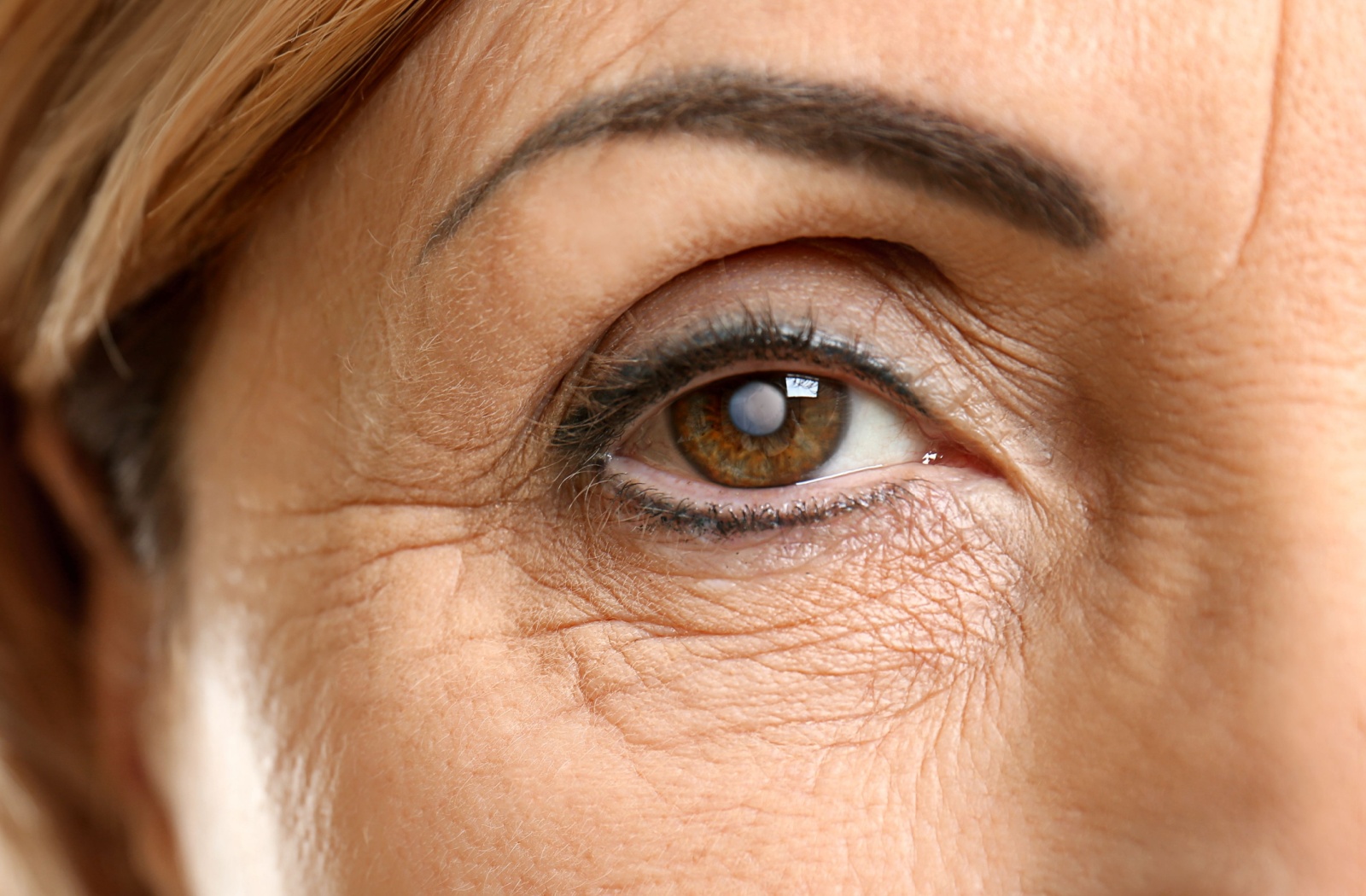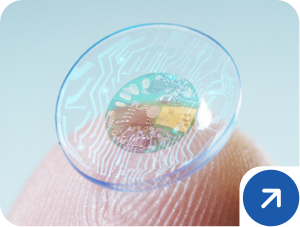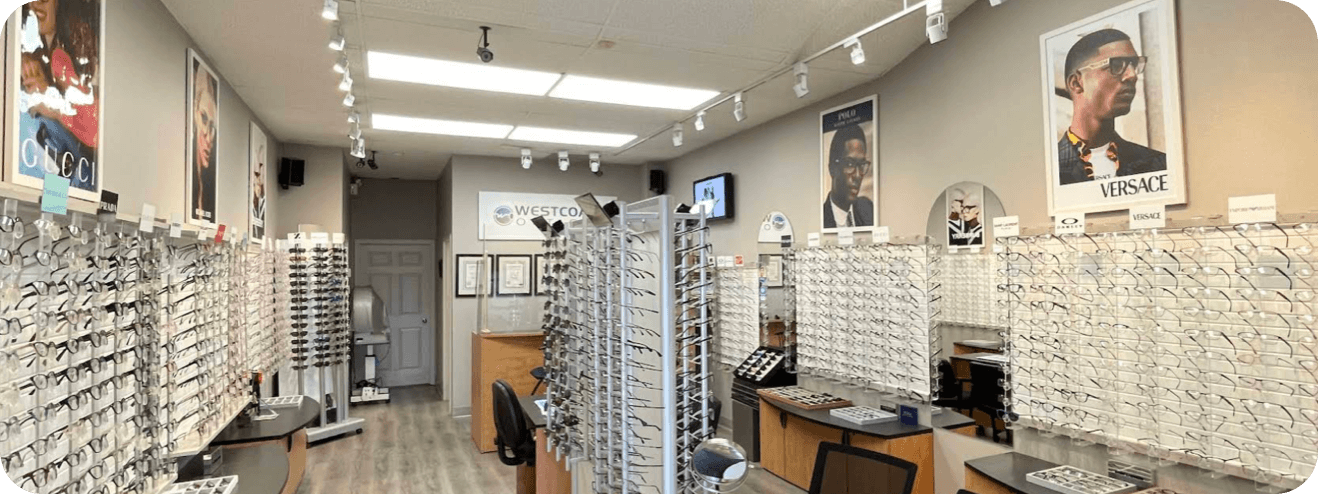Cataracts are one of the leading causes of vision impairment worldwide. But the good news is that early detection and treatment can help preserve your sight. Some of the first signs of cataracts to be aware of include:
- Cloudy or blurry vision
- Difficulty seeing at night
- Light sensitivity
- Fading or yellowing colours
- Frequent prescription changes
- Double vision in one eye
One of the things that can make cataracts tricky to detect is the fact that the changes can be very gradual. So, one may not notice the changes at first. That’s why it’s essential to get regular eye exams as recommended by the Canadian Association of Optometrists (CAO) and your eye doctor.
What Are Cataracts?
Cataracts occur when the natural lens in your eye becomes cloudy, reducing your ability to see clearly. Think of your eye’s lens like a window—it can fog up over time, preventing light from passing through properly. This clouding usually develops slowly, so you might not notice an immediate change. But as the cataracts progress, they can significantly impair your vision.
Cataracts are prevalent with aging but can also result from genetics, injuries, certain illnesses, and eye surgeries. The condition can affect one or both eyes, though it doesn’t spread between them.
Initial Cataract Symptoms
One of the tricky things about cataracts is how slowly they develop, often without noticeable symptoms at first. If any of these signs sound familiar, it’s a good idea to consult an eye doctor sooner rather than later.
Cloudy or Blurry Vision
Do things seem slightly out of focus, even when wearing glasses? This gradual cloudiness is often one of the first indicators of cataracts.
Difficulty with Night Vision
Driving at night may become a challenge. You might notice increased glare from headlights or an overall dimness that makes it challenging to see clearly in low light.
Sensitivity to Light & Glare
Bright sunlight or artificial lighting may start to feel harsher than usual. Halos or excessive glare can make certain lighting environments unbearable.
Fading or Yellowing of Colors
Do colours seem dull or washed out? Cataracts can make whites look yellowish and decrease the vibrancy of the world around you.
Frequent Prescription Changes for Glasses
If your glasses or contact lens prescription changes every few months, it could be a hidden sign of cataract progression. There could be other causes for frequent prescription changes, so it’s essential to consult your eye doctor.
Double Vision in One Eye
Sometimes, people with cataracts experience double vision in one eye (monocular diplopia). This typically disappears when the cataracts are treated.

What Happens When Cataracts Progress?
Cataracts will typically continue to worsen, gradually impairing more aspects of your vision. The once-subtle symptoms—like halos, blurred vision, and dull colours—will become more pronounced. Eventually, cataracts can lead to significant vision loss, making everyday tasks like reading, driving, or walking in unfamiliar areas difficult or even dangerous.
How Are Cataracts Diagnosed & Treated?
Your first step should be scheduling an appointment with an eye doctor for a comprehensive eye exam if you suspect you may have a cataract developing. A cataract diagnostic process typically includes:
- A visual acuity test measures how well you can see at various distances.
- A slit-lamp exam uses a special microscope to examine the lens and other parts of the eye more closely.
- A retinal exam evaluates the retina after dilating your pupils to check for cataracts’ impact on the back of your eye.
Treatment Options
Surgery is usually recommended when cataracts significantly interfere with your vision and daily activities. Cataract surgery is one of the safest and most common procedures performed worldwide. The procedure involves removing and replacing the cloudy lens with an artificial intraocular lens (IOL). The surgery is typically done as an outpatient procedure with minimal downtime.
New advances in cataract surgery allow customized lenses to correct other vision issues like astigmatism or presbyopia, leaving you with improved overall sight.
Can Cataracts Be Prevented?
While you can’t entirely prevent cataracts (especially if they’re age-related), small lifestyle changes can go a long way in protecting your vision. Several steps you can take to delay cataract onset or progression include:
- Wear sunglasses with UV protection to shield your eyes from harmful sunlight
- Maintain a healthy diet rich in antioxidants, such as leafy greens, fruits, and fish full of omega-3 fatty acids
- Avoid smoking to reduce your risk of cataract development
- Control medical conditions like diabetes by following your doctor’s advice and managing blood sugar levels
- Get regular eye exams because early detection makes a big difference
Take the Next Step in Caring for Your Vision
Cataracts may be a common vision issue, but being informed can help you take proactive measures to protect your sight. By understanding the first signs and taking preventive steps, you’ll be better equipped to address any changes before they interfere with your quality of life.
If you’re experiencing any of the symptoms mentioned above or just want to check in on your eye health, call us today at West Coast Optical and book an appointment with one of our experienced eye doctors.















